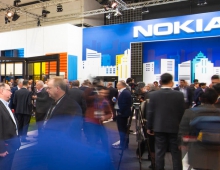
Nokia Completes Solar Energy Project
Nokia's research project on phone charging using
harvested solar energy has now been completed. Can the
sun be relied on to charge your phone?
Nokia is searching for improved energy efficiency and
more sustainable alternatives for mobile phone users.
Last June, the company announced the Nokia Solar
Charging Project, a research project designed to assess
the viability and ease of solar charging for mobile
phones. The idea was also to look at the possibilities
for phone charging in conditions where it's not
possible to plug in to recharge the phone, or where the
electricity supply is uncertain.
Nokia's testers started with developing a prototype phone for the project featuring a solar charging panel integrated in the back cover for harvesting solar energy. The small solar charging panels developed for this project have been integrated to Nokia C1-02 devices, while a data logger will report the harvested solar energy. The phone was tested last summer by a team of five people in a range of different environments. Two of the phones were tested up north at the Arctic Circle, one in southern Sweden and one in Kenya, and the fifth member of the test team was sailing in the Baltic Sea.
Nokia's tests showed that charging a mobile phone by simply using a solar charging panel on the back cover is possible but challenging.
When carefully positioned, the prototype phones were able, at best, to harvest enough energy to keep the phone on standby mode but with a very restricted amount of talk time. This means there's still some way to go before a workable and care-free solution is achieved. The most substantial challenge was the limited size of a phone's back cover, which restricted the extent to which the battery can be charged. What's more, to ensure mobility, it is essential that the phone's weather protection doesn't cover the solar charging panel.
Nokia concluded that the amount of charge generated for use by the phone is not solely dependent on the weather conditions and the amount of sunlight. Factors such as lifestyles and the angle of light also have a significant impact on the amount of charge generated, the company said.
The greatest amount of charge was generated in Kenya, as there was no shortage of sunlight. From the energy profile of the phone, Nokia 's tested in Kenya was an active phone user, listening to the radio and making a lot of calls. Nonetheless, in 59 days, Nokia's kenya-based tested gained 20 hours talk time or sufficient standby for 41 days.
On the Arctic Circle, by contrast, the amount of sunlight depends very much on the time of year. But even during the light summer months, the sun's angle is relatively low, which means a lot of shadows. If the user is frequently on the move, the phone will receive a fairly low charge. Nevertheless, a test record was achieved at the Arctic Circle, as Nokia's tester, was able to move his phone from one side of the house to another to track the summer sun as he got on with his house-building work.
Reasonably good results were also obtained when the tester was able to carry the phone while moving around outdoors, for instance in a holder around his neck. However, this isn't necessarily the most stylish or convenient arrangement, and another solution is needed.
Nokia's testers started with developing a prototype phone for the project featuring a solar charging panel integrated in the back cover for harvesting solar energy. The small solar charging panels developed for this project have been integrated to Nokia C1-02 devices, while a data logger will report the harvested solar energy. The phone was tested last summer by a team of five people in a range of different environments. Two of the phones were tested up north at the Arctic Circle, one in southern Sweden and one in Kenya, and the fifth member of the test team was sailing in the Baltic Sea.
Nokia's tests showed that charging a mobile phone by simply using a solar charging panel on the back cover is possible but challenging.
When carefully positioned, the prototype phones were able, at best, to harvest enough energy to keep the phone on standby mode but with a very restricted amount of talk time. This means there's still some way to go before a workable and care-free solution is achieved. The most substantial challenge was the limited size of a phone's back cover, which restricted the extent to which the battery can be charged. What's more, to ensure mobility, it is essential that the phone's weather protection doesn't cover the solar charging panel.
Nokia concluded that the amount of charge generated for use by the phone is not solely dependent on the weather conditions and the amount of sunlight. Factors such as lifestyles and the angle of light also have a significant impact on the amount of charge generated, the company said.
The greatest amount of charge was generated in Kenya, as there was no shortage of sunlight. From the energy profile of the phone, Nokia 's tested in Kenya was an active phone user, listening to the radio and making a lot of calls. Nonetheless, in 59 days, Nokia's kenya-based tested gained 20 hours talk time or sufficient standby for 41 days.
On the Arctic Circle, by contrast, the amount of sunlight depends very much on the time of year. But even during the light summer months, the sun's angle is relatively low, which means a lot of shadows. If the user is frequently on the move, the phone will receive a fairly low charge. Nevertheless, a test record was achieved at the Arctic Circle, as Nokia's tester, was able to move his phone from one side of the house to another to track the summer sun as he got on with his house-building work.
Reasonably good results were also obtained when the tester was able to carry the phone while moving around outdoors, for instance in a holder around his neck. However, this isn't necessarily the most stylish or convenient arrangement, and another solution is needed.





















